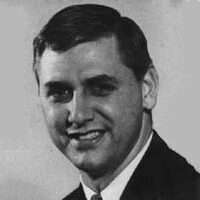David Meeker
- 1968

Fellowship Title:
- Urban Problems in Europe
Fellowship Year:
- 1968
Urban Europe’s Examples For America
January 5, 1969 LONDON, ENGLAND — Seven out of every ten United States citizens live in urban America. Half the population of the United States lives on one percent of the nation’s land. That is the crux of America’s urban problem, and behind the simplicity of those two facts lies what is certainly the nation’s most complex and demanding challenge. Another certainty is that the challenge will be greater tomorrow, and greater still the next day, for urban living — with so many economic, educational, cultural and social opportunities — has become the American way of life. People enjoying people at a Dutch sidewalk cafe. Urban living, at the same time, has given Americans ugliness, inconvenience, slums old and now, and a host of daily tribulations. The question is whether urban life demands the nation to accept such conditions, or whether urban America can order its life to avoid such a severe penalty. Europe has been grappling with urban problems for more than 2000 years. Because of its differences in living style, culture, and
Rapid Transit: A Matter Of Decision
November 27, 1968 ROTTERDAM, HOLLAND — As more and more Europeans discover the automobile, their cities are rediscovering the value of rapid transit. From Helsinki to Rome and Munich to London, the drawing boards are sprouting designs for new or expanded subway systems and hundreds of miles of track is being laid. Rotterdam, too, has gotten into the act — in a small way. The now Metro here is neither big nor elaborate. It’s less than four miles long and has only seven stations. Rotterdam’s Metro is remarkable only because it was built. A Metro train zips along the Rotterdam harbor In developing the first rapid transit system in the Netherlands with no financial help and in the face of great technical problems, this city has demonstrated that better public transportation is available to any city that wants it badly enough. It’s a matter of decision. “Enemy number one…” Before taking up the question of a Metro, Rotterdam first had to endorse the general concept of expanded public transportation. It did so despite the
Rotterdam Rides Tomorrow’s Tide
October 30, 1968 ROTTERDAM, HOLLAND — Contrary to popular opinion, the Dutch have not completely repulsed the sea. In Rotterdam, they have captured it and put it to work. The bent for the sea is so strong here that the entire city seems ready to sail with the next tide. Rotterdam — sitting at the mouth of the Rhine-Maas, Europe’s busiest river complex — was willed by geography to be a port. But that Rotterdam today should be the world’s greatest port has been willed only by strong and determined Dutchmen. “Waiting for the ships…” A century ago, ships bound for Rotterdam struggled through the Maas river estuary from the North Sea. Its winding route and continuous silting made this a slow and costly connection. Then, in 1872, work was finished on a new waterway cut straight to the sea through the coastal dunes. Rotterdam’s course was plotted. By the eve of World War II, Rotterdam had become a busy port, though not one of Europe’s biggest. The war found Rotterdam occupied by German
City Wanted: No “Miracles” Need Apply
September 20, 1968 STOCKHOLM, SWEDEN — People everywhere are looking for something they call “a good place to live.” American planners refer to it as “a suitable environment. The Swedes term it “miljö.” With the good life becoming harder to find in modern cities, manes recent attempts to foster it have often resembled the efforts of the medieval alchemists who tried to change lead into gold. Using bulldozers to dispense an exotic potion named urban renewal, the urban alchemists have seen the old leaden cities transformed, indeed — into new leaden cities. Dismayed city dwellers have witnessed the experiments, shrugged their shoulders, and gone to the suburbs in search of the golden life. If ever the Swedes had faith in urban alchemy, they seem to have abandoned it, at least here in the capital. Their quest for miljö (mil-yoo) has turned toward the realism of people, money, work, and time, with the emphasis on people. In Södermalm, Stockholm’s newest -urban laboratory, no miracles are planned. ‘Look Upon a Balance’ Södermalm, known as “Stockholm’s Brooklyn”
Stockholm Pays The Price…and Shows It
STOCKHOLM, SWEDEN — When I told a Swedish friend in Warsaw that I had managed to rent an apartment in the Farsta area of Stockholm, he frowned and said, “Oh, well. You only plan to stay three months.” Upset by his reaction, I pressed for an explanation and was told that Farsta was a “not-so-nice, lower-class section.” With this warning in mind, my wife and I arrived in Farsta a few weeks later and were amazed to find a neat, modern community with attractive buildings blended into the granite-and-fir landscape, large play areas where children are safe from traffic, and a wealth of facilities for shopping or recreation. Stockholm City Hall at twilight Our friend, we remarked, must have been confused, or perhaps he was a bit of a snob. Now, after two months here and some reflection, it occurs that perhaps he was neither. Our pleasant impression of Farsta has not changed. But, as he said, it is “lower class.” To an American who has lived his life in its cities, a lower-class neighborhood
